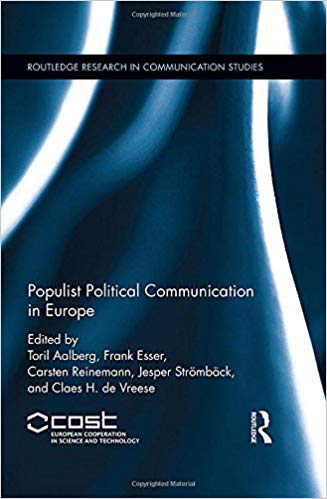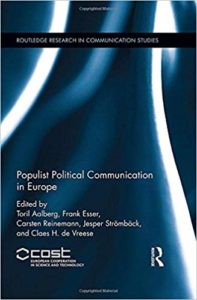
Populist Political Communication in Europe by Toril Aalberg, Frank Esser, Carsten Reinemann, Jesper Strömbäck, and Claes H. de Vreese

This book takes stock of the research on populist political communication in Europe at a time when the populist Zeitgeist is at its peak. It is a timely addition to the rapidly increasing literature on the hot topic of populism. The bulk of the volume is made up of no less than 24 country chapters, each composed of four sections – an introductory overview over the research on populism in a given country, and one section each on populist actors as communicators, on the media as channel for populist communication, and on the effects of populist communication on the citizens. The chapters are grouped by region – Northern (4 chapters), Western (7), Southern (6) and Eastern Europe (7). Each chapter not only reviews the international literature, but also the native-language research on populism in the country in question, which makes this a particularly valuable source-book for the comparative study of populism. The country chapters are introduced by two conceptual chapters and summarized in three concluding chapters written by the editors – one each for the three main actors engaged in populist communication: the political actors, the media and the citizens.
Populism is understood by the contributors to this volume as an ideology or a discourse – the editors are not given to fine distinctions between the two. Following Jagers and Walgrave (2007), they concentrate on “references to the people, anti-elitism, and anti-out-group messages as key elements of populist political communication” (15) and they distinguish between “empty populism” (only references to the people), “exclusionary populism” (references to the people and to the exclusion of outgroups), “anti-elitist populist” (references to the people combined with attacks on the elites), and “complete populism” (a combination of all three elements).
Reading the country chapters can be quite frustrating, because time and again the reader is told that very little systematic research on populist actors as communicators, on the relationship between the media and populism, and on the effects of populist political communication on citizens exists in the country covered by the chapter. In the absence of such research, the country chapters often focus on conceptual debates, on the presentation of the populist actors (mostly parties of the radical populist right) or an uneasy mixture between the two, as well as on the social-demographic composition of the voters of the populist parties in the country in question – all topics on which more research has been done and on which a large number of publications exist already, but which do not directly speak to the topic of populist political communication addressed in this volume.
Although they only indirectly speak to the topic of the volume, some of the conceptual discussions of populism in the country chapters are of more general interest, because they clarify the sources of confusion that exist in the debate on populism. Thus, in the Hungarian scholarly literature, populism is primarily associated with mainstream political forces, not with anti-establishment parties from the radical right, which reflects the generalized diffusion of populism in the Hungarian party system (00): “In a political environment so polluted by populism, most scholars have refrained from contrasting populism with mainstream normality.” The chapters on Southern European countries, but also the ones on Germany or Belgium, distinguish between populism from the left and from the right – a distinction that is ill-suited to the typology of populism guiding the entire enterprise: given its reliance on Jagers and Walgrave, who introduced their typology for the study of the radical populist right in Belgium, the typology of populists used by the contributors of the volume is hard-pressed to accommodate the more inclusionary types of populism from the left which prevail in the South of Europe (see Mudde and Rovira-Kaltwasser 2013). Among several others, the Italian chapter reveals another shortcoming of the conceptual framework: Berlusconi’s populism is difficult to situate in this framework. It has been defined as “centre-right populism” and relies on two essential elements of populism: the direct appeal to the people and the direct link between the people and the leader. The latter is an element of populist strategy that is not explicitly covered by the volume’s conceptual framework. The French chapter refers to the discussion among French scholars who, indeed, distinguish between populism as an ideology and as a strategy (182). In several chapters we read about the role of leaders – in the chapter on Israel, the discussion of leaders virtually replaces the discussion on parties, but the discussion of the role of leaders and their charisma remains largely inconclusive throughout the volume. Finally, the chapter on Greece adds another missing element to the overall framework by pointing out that political actors change over time, that they may cross from the populist to the non-populist camp, and vice versa (197): PASOK is the prime example of a populist party that became a beacon of the anti-populist camp, while SYRIZA provides the counter-example of a party whose populist discourse has intensified over the course of the financial crisis.
In the concluding chapters, the editors do an excellent job of drawing together the findings of the country chapters. The chapter on the political actors as communicators usefully distinguishes between “actor-centered” and “communication-centered” approaches. The actor-centered approach studies the communication of some actors who are defined as populist, while the communication-centered approach compares the communication of various types of actors and asks to what extent it is populistic. As the chapter points out, actor-centered studies predominate, which is certainly one of the reasons why the authors of this chapter conclude “without wishing to be too critical of previous research” (355) that “systematic empirical research on populist communication in European countries is limited” (363). The chapter also reviews factors influencing the presence of populist political actors. In this respect, the authors distinguish between external demand-side conditions (short-term conditions such as economic crisis, immigration, cuts to welfare provisions, loss of national sovereignty, layered upon existing divisions between majorities and ethnic/religious minorities) and internal (charismatic or just very rich leaders) or external supply-side conditions (electoral systems, media environment). The chapter concludes that systematic empirical research comparing the political communication strategies, tactics, styles, and rhetoric of populist with non-populist actors should be a priority in future research on populist communication (363).
The summary chapter on populism and the media also confirms “the weak state of research,” and ends with a call for further research on the topic. Still, based on the country chapters, it is able to provide some general results. First, it distinguishes between three patterns of media coverage of populist parties: lack of coverage (cordon sanitaire), increasing, but negative coverage, and critical coverage (“danger for democracy”). The discussion in the Belgian chapter shows the problem of the cordon sanitaire: while all the other parties and the Belgian news media tried to impose a cordon sanitaire, the news media still extensively covered the issues owned by radical populist right (nationalism, immigration, crime), which contributed to the latter’s success at the polls. The Swedish and the Swiss case are also interesting in this respect. In Sweden, an earlier cordon sanitaire around the Swedish Democrats gave way to more extensive (negative) coverage, and as coverage went up so did the electoral success of the party. In Switzerland, the Swiss People’s Party actually receives the highest share of news attention of all the parties in both electoral and referendum campaigns. Although the news coverage of the challengers in both countries is often negative, it cannot be all bad, as the authors point out.
The chapter also provides an interesting discussion of the aspects of the discursive opportunity structure that favor the dissemination of populist messages: media logic, media ownership structure (politically or commercially motivated media ownership), party issue ownership, event environment and national issue culture. As famously asserted by Mazzoleni (2008: 52), but unfortunately not systematically studied, the unintended complicity of the media with populism constitutes the necessary background for understanding populist political communication (372). The book chapters point to three aspects of the media logic which are especially favorable to the dissemination of populism: conflict framing (reporting on issues like immigration using a conflict perspective), strategic framing (“horse race journalism”) and personalization (over-exposure of populist leaders). In addition, politically motivated media ownership (such as TV channels owned by party leaders – Dan Diaconescu in Romania, Andrej Babis and Tomio Okamura in the Czech Republic, Radio Maryja in Poland, and certainly not to forget, Silvio Berlusconi in Italy), and commercially motivated media ownership (commercial TV stations, tabloids, and free newspapers) may, although they not always do (e.g. a British study concludes, surprisingly, that there is no evidence that popular newspapers share an anti-elitist bias with populist parties (170)), favor the spread of populism. Third, the media can, as already pointed out, unintentionally support populist parties by covering the issues owned by these parties. Fourth, certain events like large scale scandals (e.g. Finland’s campaign finance scandal or Italy’s “Clean Hands” scandal) and national crises (e.g. the financial crisis in Greece) constitute favorable conditions for populist anti-elitist discourse. Finally, populist discourse benefits from national myths and symbols – a theme that is underdeveloped in this volume, but that is to some extent elaborated in the Romanian chapter. Thus, pervasive in Romania are “the myths of the savior, of the nation under siege, and of the country’s modernization” (332). While both populist and mainstream leaders heavily rely on populist discourse, “the use of symbols and myths, or messianic and nationalistic flavors” is restricted to populists (333). The use of national cultural legacies in the political discourse is certainly a topic that deserves more attention in the study of populist political communication.
The third summary chapter on citizens and populist political communication again points out that our knowledge about the effects of populist communication on citizens is still scant. As the heuristic model for future research on the topic presented in this chapter suggests, the empirical study of such effects is, indeed, very demanding. A precondition for such a study is the measurement of populist attitudes in the general public. More recently, several attempts have been made to identify populist attitudes in the general public and to relate them to the support for populist parties and movements (Akkerman et al. 2014, Hawkins et al 2012, Hawkins and Rovira-Kaltwasser 2014, Rooduijn 2014, Schulz et al. 2017), some of which are covered by the present volume. In addition, such studies require conditions which are hardly ever met in natural settings. This is why experimental studies hold out the greatest promise here. The results of an experimental study have been reported in the Austrian chapter: Schmuck and Matthes (2015) distinguished between two different persuasive strategies in right-wing populist advertising: economic and symbolic threat appeals. While economic threats appealed only to the less educated, the symbolic threats increased negative attitudes towards immigrants across the board, suggesting that perceived threats to cultural identity are more general than perceived economic threats. The authors of the last summary chapter conclude that cross-national experimental studies might prove especially well-suited to improve on our patchy knowledge of the effects of populist political communication.
Reviewed by Hanspeter Kriesi, The European University Institute
Populist Political Communication in Europe
by Toril Aalberg, Frank Esser, Carsten Reinemann, Jesper Strömbäck, and Claes H. de Vreese (eds).
Publisher: Routledge
Hardcover / 402 pages / 2016
ISBN: 9781138654792
To read more book reviews, please click here.
Published on August 10, 2018.
References:
Akkerman, Agnes, Cas Mudde, and Andrej Zaslove. “How populist are the people? Measuring populist attitudes in voters.” Comparative political studies 47, no. 9 (2014): 1324-1353.
Hawkins, Kirk Andrew, Scott Riding, and Cas Mudde. Measuring populist attitudes. Political concepts committee on concepts and methods working paper series no. 55 (2012): 1–35.
Hawkins, Kirk A. and Cristobal Rovira Kaltwasser. The populist specter in contemporary Chile. Paper presented at the 2014 Latin American Studies Association (LASA), Chicago, IL.
Jagers, Jan, and Stefaan Walgrave. “Populism as political communication style: An empirical study of political parties’ discourse in Belgium.” European Journal of Political Research, 46, no. 3 (2007): 319-345.
Mazzoleni, Gianpietro. “Populism and the Media”. In Twenty-First Century Populism: The Spectre of Western European Democracy, edited by D. Albertazzi and D. McDonnell, Basingstoke: Palgrave Macmillan. pp. 49-64
Mudde, Cas, and Cristóbal Rovira Kaltwasser. “Exclusionary vs. inclusionary populism: Comparing contemporary Europe and Latin America.” Government and Opposition 48, no. 2 (2013): 147-174.
Rooduijn, Matthijs. “Vox populismus: a populist radical right attitude among the public?.” Nations and Nationalism 20, no. 1 (2014): 80-92.
Schmuck, Desirée, and Jörg Matthes. “How anti-immigrant right-wing populist advertisements affect young voters: Symbolic threats, economic threats and the moderating role of education.” Journal of Ethnic and Migration Studies 41, no. 10 (2015): 1577-1599.
Schulz, Anne, Philipp Müller, Christian Schemer, Dominique Stefanie Wirz, Martin Wettstein, and Werner Wirth. “Measuring populist attitudes on three dimensions.” International Journal of Public Opinion Research (2017): published online ahead of print: https://doi.org/10.1093/ijpor/edw037




